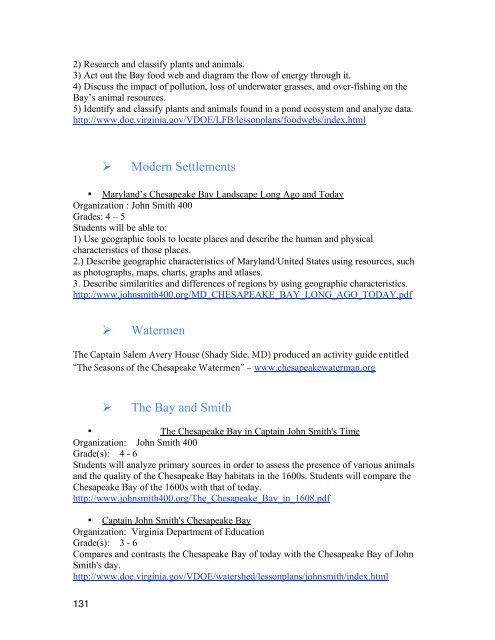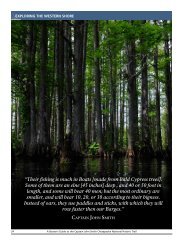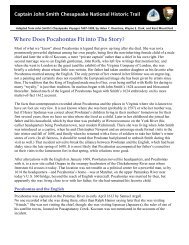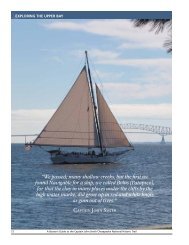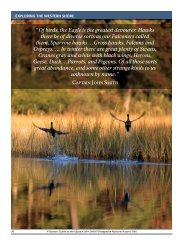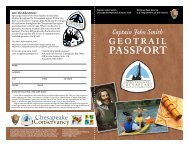Draft Interpretive Plan Join the adventure! - Captain John Smith ...
Draft Interpretive Plan Join the adventure! - Captain John Smith ...
Draft Interpretive Plan Join the adventure! - Captain John Smith ...
You also want an ePaper? Increase the reach of your titles
YUMPU automatically turns print PDFs into web optimized ePapers that Google loves.
2) Research and classify plants and animals.<br />
3) Act out <strong>the</strong> Bay food web and diagram <strong>the</strong> flow of energy through it.<br />
4) Discuss <strong>the</strong> impact of pollution, loss of underwater grasses, and over-fishing on <strong>the</strong><br />
Bay’s animal resources.<br />
5) Identify and classify plants and animals found in a pond ecosystem and analyze data.<br />
http://www.doe.virginia.gov/VDOE/LFB/lessonplans/foodwebs/index.html<br />
<br />
Modern Settlements<br />
• Maryland’s Chesapeake Bay Landscape Long Ago and Today<br />
Organization : <strong>John</strong> <strong>Smith</strong> 400<br />
Grades: 4 – 5<br />
Students will be able to:<br />
1) Use geographic tools to locate places and describe <strong>the</strong> human and physical<br />
characteristics of those places.<br />
2.) Describe geographic characteristics of Maryland/United States using resources, such<br />
as photographs, maps, charts, graphs and atlases.<br />
3. Describe similarities and differences of regions by using geographic characteristics.<br />
http://www.johnsmith400.org/MD_CHESAPEAKE_BAY_LONG_AGO_TODAY.pdf<br />
<br />
Watermen<br />
The <strong>Captain</strong> Salem Avery House (Shady Side, MD) produced an activity guide entitled<br />
“The Seasons of <strong>the</strong> Chesapeake Watermen” – www.chesapeakewaterman.org<br />
<br />
The Bay and <strong>Smith</strong><br />
• The Chesapeake Bay in <strong>Captain</strong> <strong>John</strong> <strong>Smith</strong>'s Time<br />
Organization: <strong>John</strong> <strong>Smith</strong> 400<br />
Grade(s): 4 - 6<br />
Students will analyze primary sources in order to assess <strong>the</strong> presence of various animals<br />
and <strong>the</strong> quality of <strong>the</strong> Chesapeake Bay habitats in <strong>the</strong> 1600s. Students will compare <strong>the</strong><br />
Chesapeake Bay of <strong>the</strong> 1600s with that of today.<br />
http://www.johnsmith400.org/The_Chesapeake_Bay_in_1608.pdf<br />
• <strong>Captain</strong> <strong>John</strong> <strong>Smith</strong>'s Chesapeake Bay<br />
Organization: Virginia Department of Education<br />
Grade(s): 3 - 6<br />
Compares and contrasts <strong>the</strong> Chesapeake Bay of today with <strong>the</strong> Chesapeake Bay of <strong>John</strong><br />
<strong>Smith</strong>'s day.<br />
http://www.doe.virginia.gov/VDOE/watershed/lessonplans/johnsmith/index.html<br />
131


